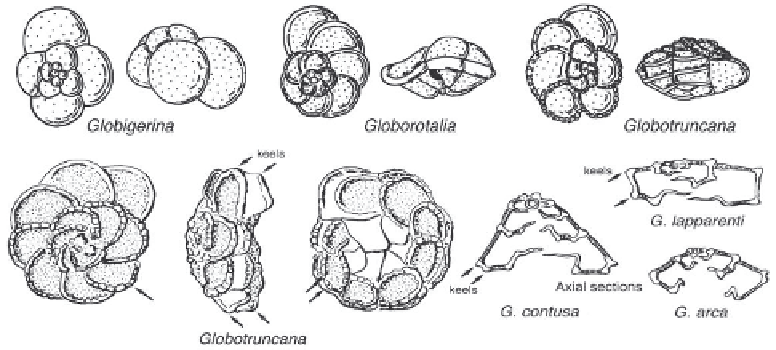Geology Reference
In-Depth Information
Plate 73 Late Cretaceous and Tertiary Planktonic Foraminifera
Planktonic foraminifera are Protista that inhabit the upper zones of the pelagic realms of the oceans. Known
since the Middle Jurassic (Triassic?), they are rock-building constituents of Cretaceous and Cenozoic deep-
marine limestones, important biostratigraphic markers since the Early Cretaceous, and proxies for paleoceano-
graphic, paleoclimatologic and paleobathymetric reconstructions. About 47 % of the modern sea floor is covered
by
Globigerina
ooze.
Planktonic foraminifera are characterized by trochospirally coiled tests with inflated, perforated chambers,
sometimes with keeled outer margins (e.g. Globotruncanidae and Globorotaliidae). The wall consists of opti-
cally radial and bilamellar low-magnesian calcite. The observation of wall structure and surface ornamentation
in thin sections is not practicable in all cases, but is currently refined by the analysis of oriented sections across
isolated tests. Widely used in the correlation of Late Cretaceous open-marine carbonates are species of
Globotruncana
(-> 1, 2, 5, 8), in Cenozoic carbonates
Globorotalia
,
Globigerina
(-> 9) and
Orbulina
(-> 10).
Globotruncana
is differentiated according to the number of keels that can be recognized in axial sections (single-
keeled -> 8; double-keeled -> 7).
1 Axial and tangential sections of different planktonic foraminifera, including
Whiteinella
with trochospirally coiled tests
and globular chambers. Late Cretaceous (Seewer limestone, Turonian): Glacial boulder, near Bern, Switzerland.
2 The occurrence of planktonic foraminifera (double-keeled
Globotruncana -
G,
Heterohelix
- H) associated with abun-
dant 'calcispheres' (
Pithonella,
see Pl. 66/4, 5) indicates an open-marine deep-shelf depositional environment. Turonian
(Seewer limestone): Seewen, Switzerland.
3 Planktonic foraminiferal packstone predominantly with
Praeglobotruncana.
Late Cretaceous: Siliana near Maktaris,
Northern Tunisia.
4 Planktonic foraminiferal packstone with
Morozovella
McGowran. Genus range: Paleocene to Middle Eocene. Paleo-
gene: Central Apennines, Italy.
5
Globotruncana
Cushman (G, axial section) and
Heterohelix
Ehrenberg (H)
.
High-trochospiral globotruncanids are com-
mon in Maastrichtian open-marine pelagic limestones. Genus range of
Globotruncana
: Santonian to Late Maastrichtian.
Single-keeled (arrows) globotruncanids as in this sample are typical of a Campanian or Maastrichtian age.
Heterohelix
:
Late Aptian to Paleocene. Maastrichtian: Delphi, Greece.
6
Heterohelix
Ehrenberg. Note early planispiral and later biserial growth of the high trochospiral test. The maximum
development and spreading of large heterohelicid foraminifera occurred in the Maastrichtian. Late Cretaceous: Northern
Tunisia. The sample represents rock material used for Roman mosaics in Carthage.
7
Marginotruncata
Hofker. Double-keeled form (arrows). Generic range: Turonian to Santonian. Spreading of double-
keeled planktic foraminifera started in the Turonian and Coniacian. Late Cretaceous: Northern Tunisia.
8
Globotruncana stuartiformis
Dalbiez and
Globotruncana
ex gr.
arca
(Cushman) - top right. Axial sections of single-
keeled forms. Note the difference between the infillings of the tests and the dense pelagic carbonate mud. Arrows point
tp the diagnostically important keels. Early Maastrichtian: Delphi, Greece.
9 Globigerinid wackestone with
Globigerinoides
. Coiled tests are cut in all planes. Note the globular chambers and the
coarsely perforated calcitic walls. Genus range: Eocene to Holocene. Miocene: Southern Turkey.
10
Orbulina
(O)
-Globigerina
(G) packstone. Spherical test. Wall calcareous, with numerous smaller pores interspaced among
a few larger pores.
Orbulina
is common in Middle and Late Miocene deep shelf and basinal limestones. SMF 3-F
OR
.
Miocene: Camposauro, southern Apennines, Italy.
Typical planktonic
foraminifera. After
Ziegler (1983).
Exterior views and
axial sections of
Glo-
botruncana
. Arrows
point to keels. After
Bignot (1985).

